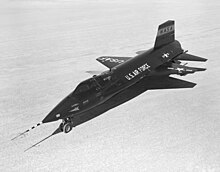
Summary
An air data boom provides air pressure, temperature, and airflow direction data to data acquisition systems for the computation of air, ground, and water vehicle orientation, speed, altitude/depth, and related information. Air data booms can be used as primary sensors or as a "measurement standard" of which primary sensors and instruments are compared to.

Purpose and overview edit
An air data boom is used to collect source data during the testing of air vehicles, ground vehicles, and water-borne vessels. The air data boom is mounted on the vehicle in a location that allows for relatively undisturbed air to be measured. To attain such undisturbed air, mounting is usually done on the nose, wing, or upper horizontal stabilizer of the vehicle.
Typical components edit
Air data booms may measure one, some, or all of these capabilities:
- angle of attack (AoA, alpha)
- angle of sideslip (AoS, beta)
- static pressure (Ps)
- total pressure (Pt, pitot pressure)
- outside air temperature (OAT)
- total air temperature (TAT)
Specialized air data booms may also contain mission-specific sensors such as humidity sensors, ice detectors, accelerometers, strain gages, and the like.
Synonyms edit
An air data boom may be referred to by a variety of names, including:
- flight test boom
- vehicle test boom
- nose boom
- wing boom
- YAPS head (for Yaw-And-Pitch Sensor head)
Manufacturers edit
Most air data booms are either procured from niche manufacturers such as SpaceAge Control,[1] Goodrich,[i],[2] or created by vehicle manufacturers, R&D facilities, and test organizations.
See also edit
References edit
Notes edit
- ^ Since 2012, part of UTC Aerospace Systems
External links edit
- Airdata Measurement and Calibration
- Calibration of Air Data Systems and Flow Direction Sensors
- Wind-Tunnel Calibration of a Combined Pitot-Static Tube and Vane-Type Flow-Angularity Indicator at Mach Numbers of 1.61 and 2.01


